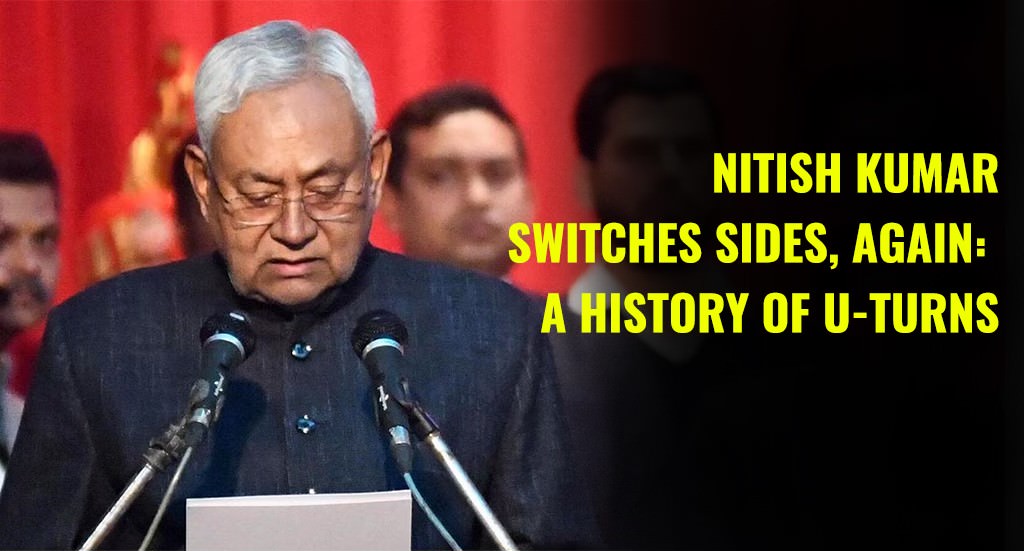Nitish Kumar yet again switched over from one alliance – the mahagathbandhan – to another to stay in power as he was sworn in as the Chief Minister of Bihar for an unprecedented ninth term, heading a new government forged in collaboration with the BJP.
As the collective endeavours advanced to the pivotal phase of seat negotiations, Nitish Kumar made the decisive move on Sunday to abandon the Rashtriya Janata Dal, Congress, and his Left allies. Instead, he opted to form a government with the Bharatiya Janata Party, dealing a significant setback to the alliance’s prospects, particularly in Bihar, the sole Hindi-belt state where the alliance held power.
Nitish Kumar is substituting his Rashtriya Janata Dal ministers with BJP members, and alongside him, party figures like Samrat Chowdhury, Vijay Sinha, and numerous others also took the oath at the Raj Bhavan.
This marks the fifth occasion in the span of a decade that the 72-year-old leader has switched alliances, a pattern that has led to him being derisively labeled as “Paltu Kumar.”
Mr Kumar’s last split with the BJP occurred in 2022. Back then, the Chief Minister was apprehensive that the BJP might replicate their strategy from Maharashtra, where they engineered a division within the Shiv Sena, within his own Janata Dal United.
Sharad Pawar, the veteran of the Nationalist Congress Party, has been surprised by Bihar Chief Minister Nitish Kumar’s choice to withdraw from the ‘mahagathbandhan’ or grand opposition alliance and reunite with his former ally, the NDA led by the Bharatiya Janata Party, on Sunday.
Nitish Kumar’s History of Flip Flops
1. Nitish Kumar began his inaugural term in 2005, forming a government in collaboration with the BJP. The rupture in their alliance commenced in 2013 when he severed ties with the BJP, terminating the JD(U)-BJP alliance spanning 17 years. Allegedly, Kumar was discontented with the declaration of Narendra Modi as the prime ministerial candidate. In the 2014 Lok Sabha elections, Kumar contested independently, securing merely two seats compared to the 18 obtained in the 2009 polls.
2. Assuming accountability for his party’s setback in the 2014 elections, Kumar resigned as the Chief Minister of Bihar and appointed Jiten Ram Manjhi as his successor. Surviving the floor test with the support of his former rival, Lalu Prasad Yadav’s RJD, Kumar orchestrated a coalition victory in the 2015 assembly polls, reclaiming his position as CM. However, his discontent resurfaced when he perceived his party’s diminished influence within a larger coalition, with the RJD enjoying majority support.
Fractures within the coalition started surfacing as Mr Kumar openly endorsed the BJP’s initiatives on demonetisation and the GST. Concerns about preserving his ‘clean’ image’ heightened after the Central Bureau of Investigation (CBI) implicated Lalu Yadav and his family in a corruption case. Resigning once more as CM in 2017, Kumar was reinstated to his position after rejoining the NDA and securing a majority in the assembly.
3. Being relegated to a subordinate role within the coalition has been a source of unease for Kumar, a sentiment that was echoed during the 2020 assembly polls. He grew apprehensive about the erosion of his party’s authority as the BJP surpassed them in seat count. The coalition eventually disintegrated in 2022 following simmering tensions over two years. The JD(U) levelled accusations against the BJP of orchestrating attempts to fragment the party and consequently terminated their alliance. With the support of the RJD, Kumar’s party once again secured a majority in the assembly, enabling him to retain his position as Chief Minister.
Nitish Kumar’s leaning for political switches is not unique to him alone – leaders across different parties, including the BJP and the Congress, exhibit similar tendencies.
According to political strategists, this also highlights the inconsistency in the position of BJP. It is observed that BJP members, who previously criticised Nitish Kumar for various issues following his departure from the NDA in 2022, are now embracing him back into their ranks.
Kumar defended his decision to exit the Mahagathbandhan alliance, citing dissatisfaction with the prevailing circumstances. He mentioned receiving input from various sources, including members of his own party, which influenced his choice to resign and establish a government with the BJP.
Now only time will tell what happens in the next elections.








